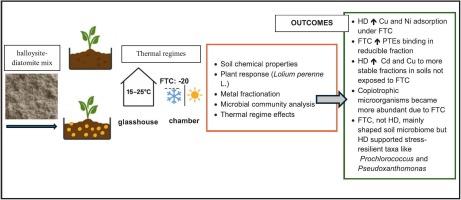矿物混合物修正植物稳定下土壤有毒元素和微生物群的热状态依赖行为
IF 5
2区 农林科学
Q1 SOIL SCIENCE
引用次数: 0
摘要
这是第一个研究高岭土-硅藻土(HD)矿物添加剂对在多金属严重影响的土壤中与本地微生物群一起种植的黑麦草(Lolium perenne L.)的影响,特别是关于草的生长,微生物活性,土壤过程和潜在有毒元素(pte: Cd, Ni, Cu, Pb)行为的研究。采用了两种实验室规模的、特定地点的热环境:一个较暖的温室(15-25°C)和一个较冷的冻融室(FTC; - 20-20°C)。首先,(i)在每个热状态下分别比较了未富集和高富集土壤。其次,(ii)对每种土壤类型分别进行了温室与冻融制度的比较。这些比较是为了(i)评估不同热条件下土壤富集的效果,(ii)评估每种土壤类型从暖到冷(w到c)的温度转变。hd基改性剂增强了金属吸附,特别是在冻融条件下(Ni > Pb > Cu > Cd)。在温室中,HD增加了Ni(7%→15%),降低了Cu(9%→4%),Pb/Cd变化较小。冻融稳定了Cu、Pb和Cd,而Ni保持流动性。富hd土壤的w - c温度转变增强了Cu/Ni的吸附,不影响Cd的吸附,并略微降低了Pb。非富营养化土壤中流动Cd(56%→25%)和Pb(9%→4%)急剧下降,Ni/Cu变化不大。在富含hd的土壤中也出现了类似的趋势。冻融增加了营养类群,HD促进了原绿球藻和假黄单胞菌的生长,减轻了某些微生物类群的冻融胁迫。这些发现表明季节变化是减少土壤污染和增强土壤功能的关键驱动因素。本文章由计算机程序翻译,如有差异,请以英文原文为准。

Thermal regime-dependent behaviour of soil toxic elements and microbiota under mineral mix-amended phytostabilisation
This is the first study to provide insights into the effects of a halloysite-diatomite-based (HD) mineral amendment on Lolium perenne L. grass cultivated with a native microbiome in heavily multimetal-impacted soil, specifically regarding grass growth, microbial activity, soil processes, and the behaviour of potentially toxic elements (PTEs: Cd, Ni, Cu, Pb). Two lab-scale, place-specific thermal regimes were applied: a warmer glasshouse (15–25 °C) and a colder freeze-thaw chamber (FTC; −20–20 °C). Firstly, (i) unenriched vs. HD-enriched soils were separately compared within each thermal regime. Secondly, (ii) for each soil type separately, glasshouse vs. freeze-thaw regimes were compared. These comparisons were made to (i) evaluate the effect of soil enrichment under different thermal conditions and (ii) assess the warm-to-cold (W-to-C) temperature transition for each soil type. The HD-based amendment enhanced metal adsorption, particularly under the freeze-thaw (Ni > Pb > Cu > Cd). In the glasshouse, HD increased mobile Ni (7 % → 15 %) but decreased Cu (9 % → 4 %), with minor Pb/Cd changes. Freeze-thaw stabilised Cu, Pb, and Cd, while Ni remained mobile. The W-to-C temperature transition in HD-enriched soils enhanced Cu/Ni adsorption, unaffected Cd, and slightly decreased Pb. Unenriched soils showed sharp drops in mobile Cd (56 % → 25 %) and Pb (9 % → 4 %), with modest Ni/Cu changes. A similar trend appeared in HD-enriched soils. Freeze-thaw increased copiotrophic taxa, while HD promoted Prochlorococcus and Pseudoxanthomonas, mitigating freeze-thaw stress for certain microbial taxa. These findings establish seasonal shifts as a critical driver in reducing soil pollution and enhancing soil functioning.
求助全文
通过发布文献求助,成功后即可免费获取论文全文。
去求助
来源期刊

Applied Soil Ecology
农林科学-土壤科学
CiteScore
9.70
自引率
4.20%
发文量
363
审稿时长
5.3 months
期刊介绍:
Applied Soil Ecology addresses the role of soil organisms and their interactions in relation to: sustainability and productivity, nutrient cycling and other soil processes, the maintenance of soil functions, the impact of human activities on soil ecosystems and bio(techno)logical control of soil-inhabiting pests, diseases and weeds.
 求助内容:
求助内容: 应助结果提醒方式:
应助结果提醒方式:


